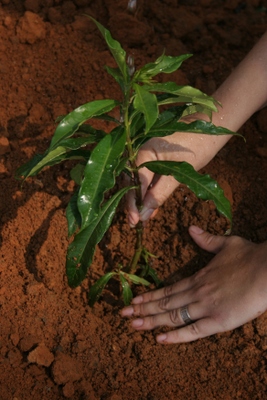50% Off First Application¹
Call 1-855-940-1479
and connect with a TruGreen consultant
Basics of Tree Fertilization
Every tree needs a healthy combination of macro and micronutrients to thrive. While a tree that grows without fertilizer can certainly live a long, happy life, trees fed regularly with a mad-made combination of fertilizer have been shown to perform better than those that aren’t.
The good news is that trees don’t need a lot of fertilizer and don’t even necessarily need to be fertilized every year. One of the biggest mistakes homeowners make is to confuse fertilizer with food. Trees get most of the “food” they need from sun and water, so overfertilization can actually cause more harm than good. Fertilizer should be used to enhance a tree’s growth, not correct huge problems.
If a tree or trees in your yard show any of the following signs, check with a lawn care provider in your area to determine if your trees are suffering from disease, pests, or any other ailment that fertilizer can’t correct:
- Yellowed leaves
- Dying branches or whole limbs
- Fewer leaves than normal
- Leaves with dead spots
- Wilty foliage or blooms

Types of Tree Fertilizer
Much like fertilizers used for grass growth, tree fertilizers come in many shapes and sizes. Some are sold as granules or pellets while some are liquid or need to be spread like seed. The type of fertilizer you need will depend greatly on your goals for tree growth and on your area’s climate and general growing pattern.
NATURAL FERTILIZERS are a more and more preferred method of home gardeners. Most natural fertilizers are carbon based and are completely organic and therefore safer for kids, pets, and water sources. They can be expensive, however, and the nutrient content included is difficult to predict.
SLOW-RELEASE FERTILIZERS release nutrients slowly, over time, due to the continuous breakdown of a protective coating on each fertilizer pellet. They work well to maintain healthy trees for months at a time and don’t need to be applied that frequently, but they can leech into groundwater.

How to Apply Tree Fertilizers
In general, always wait 6-8 months to fertilize a tree planted in the fall to give the tree time to establish a stable root system. If planted in the early spring, fertilizer should be applied to a tree at least 6-8 weeks after planting for the same reason.
New trees are far more delicate than established trees and need less fertilizer to begin with. If possible, fall fertilization performs better for established trees but should only be applied after the last frost. If you must fertilize your trees in spring, be sure to wait until the ground temperature is above 40 degrees.
When spreading fertilizer around the base of your tree, be sure to cover the entire root system. Remember that the roots can extend 3-5 feet beyond the base of the tree so you should be sure to seed at least that far. Wait to water your trees at least 48-hours after a fertilizer application.
If you’d rather let the professionals handle your tree fertilization needs, call an expert in your area. Your trees’ needs depend greatly on your climate and chosen species.

TruGreen will gladly visit your property as often as needed between scheduled visits to make any necessary adjustments and to ensure your satisfaction.
Getting Started with TruGreen
- Call or fill out the form above to reach a lawn care specialist.
- Know the square footage of your yard, as well as any specific areas of concern.
- With the help of your specialist, create a customized lawn care plan that meets your lawn’s needs.
- Schedule your Healthy Lawn Analysis2 to start your service.
